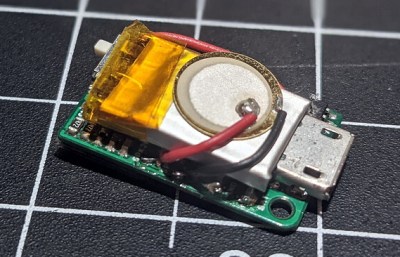One of the selling points of the Arduboy is how slim [Kevin Bates] was able to get the Arduino-compatible game system, which is perhaps less surprising when you realize that it originally started out as a design for an electronic business card. But compared to the recently unveiled Nano version, it might as well be the old school “brick” Game Boy.
 Now to be clear, [Kevin] isn’t looking to put these into official production. Though it does sound like the bare PCBs might be going up for sale in the near future. This was simply an experiment to see how far he could shrink the core Arduboy hardware while still keeping it not only playable but also code-compatible with the full-size version. While “playable” might be a tad subjective in this case, the video after the break clearly demonstrates that it’s fully functional.
Now to be clear, [Kevin] isn’t looking to put these into official production. Though it does sound like the bare PCBs might be going up for sale in the near future. This was simply an experiment to see how far he could shrink the core Arduboy hardware while still keeping it not only playable but also code-compatible with the full-size version. While “playable” might be a tad subjective in this case, the video after the break clearly demonstrates that it’s fully functional.
Inside the 3D printed case is the same ATmega32U4 that powers the Arduboy, a 64×32 0.49″ OLED display, and a tiny 25 mAh pouch battery. There’s even a miniature piezo speaker for the bleeps and bloops. All of the pinouts have remained the same so existing code can be moved right over, though the screen is now connected over I2C. [Kevin] has released the schematics for the board in keeping with the general open nature of the Arduboy project, though for now he’s decided to hold onto the board files until it’s clear whether or not there’s a commercial future for the Nano.
We’ve seen attempts to shrink the Arduboy down before, most notably down to the point it could fit inside of a Dreamcast Visual Memory Unit, but the Nano certainly raises (or is that lowers?) the bar considerably.
















Well it’s nice to know that if screwing around with Pym particles goes wrong, someone can make you a gameboy to keep yourself amused with until you can buy a Pym reverser ray at Walmart.
I remember in the early ’00s I had a roughly triangular keychain handheld game preloaded with simple games like snake, tetris etc. that was maybe 3″ on a side and that seemed pretty impressive at the time…well that thing was gargantuan compared to this. Although the controls were a lot easier to use :-P
Mount it on a finger ring.
And play Doom.
How exactly is this “code-compatible” if it uses a 64×32 I2C display instead of a 128×64 SPI display? Wouldn’t that theoretically mean that I could run the exact same code on this as the original? At the very least it would require library (and probably code) changes and re-compilation of the code to address the bus protocol changes and the 3/4 of the pixels that would be missing which would dramatically change the look of most games.
A lot of the attraction of the original is how slim it is, which is completely the opposite of this chunky one. Not to mention how unplayable that looks.
This seems to be nothing more than a marketing ploy to try and attract interest and sell more of the originals. Which, that’s fine, I guess.
Code-compatible != functionally compatible in this case. The original arduboy game code will run without modification, but will not really be functional if your goal is to play said game.
And yes, this does seem to be a quick project for amusement rather than a practical product with the side effect that it’ll draw interest to the much more practical arduboy.
I don’t see any issue with a company (or in this case an individual, Kevin, as he basically is the company) making pointless prototypes for the fun of it and getting some attention in the process.
That’s why it’s code compatible and not backwards compatible. You can take your arduboy game code, recompile it against the new libs (at the very least, the screen stuff has changed on backend), and it will work.
It may or may not be playable at the reduced resolution, but it will run. Certainly preferable to having to start from scratch.
And yeah, there’s really no point to the Nano other than to say it can be done. But that’s also exactly what the post says, so I don’t understand the argument.
That is impressively small. I would need multiple pairs of glasses to play that screen, but the poc is solid. I had not followed the arduboy project for a long while apparently haha.
Eagerly waiting for the next revision no larger than 2x2mm and with a single pixel display :)
I’m thinking earrings.
If he went commercial I would totally get one of these, simply as something neat to put on my keyring.